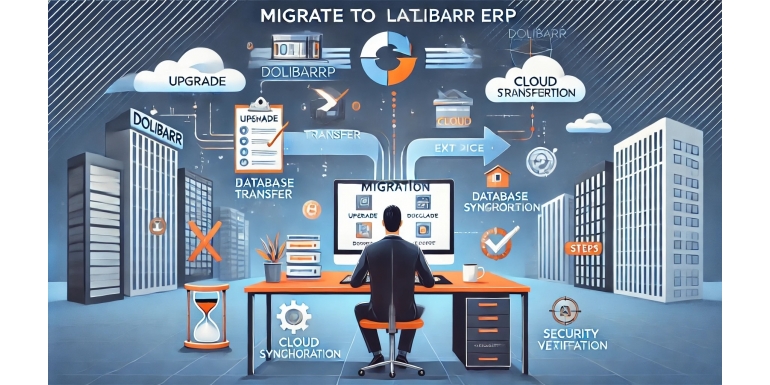
Dolibarr is an open-source ERP/CRM solution that attracts many businesses thanks to its flexibility, user-friendliness, and wide range of modules. Like any software, Dolibarr regularly evolves with new versions that bring functional improvements, security fixes, and performance optimizations. If you’re using an older version of Dolibarr, migrating to the latest release can be crucial for accessing the newest features, strengthening your system’s security, and ensuring long-term stability.
However, migrations shouldn’t be done hastily. It’s important to take a methodical approach and fully understand the steps involved to ensure a smooth transition. This article outlines the process of migrating to the latest Dolibarr version and offers practical advice for a successful upgrade.
1. Why Migrate to the Latest Version of Dolibarr?
Before diving into the migration process, it’s important to understand why it’s worth the effort. Key reasons include:
- Functional enhancements: Each new Dolibarr version introduces new features, refines existing modules, and adds modern management tools.
- Performance optimizations: Dolibarr’s developers continuously work to improve the software’s efficiency. A newer version may offer faster response times, better resource handling, and smoother navigation.
- Improved security: Older Dolibarr versions may contain known vulnerabilities. Upgrading to the latest version ensures your system benefits from the latest security patches, reducing the risk of hacks or data breaches.
- Compatibility with modules and extensions: Many third-party modules are designed to work with the latest Dolibarr versions. An upgrade allows you to take full advantage of the newest extensions and features.
2. Preparing for the Migration
Proper preparation is essential before starting the migration. This initial phase helps you identify potential challenges and avoid unexpected issues.
2.1 Backing Up Your Data
Creating backups is the most critical step before any migration. Before making any changes, perform a comprehensive backup:
- Database: Export all your data using tools like
mysqldumpfor MySQL/MariaDB databases. - Configuration and document files: Back up the directories containing your Dolibarr files (e.g., the
documentsfolder and configuration files inconf/).
Store these backups in a secure location, preferably on an external drive or a cloud storage service. If anything goes wrong, you’ll be able to revert to the previous version without data loss.
2.2 Reading the Release Notes
Each Dolibarr version comes with release notes that detail the changes, new features, and any compatibility issues. Take time to review these notes to understand what has been modified and plan any necessary adjustments.
2.3 Identifying Modules and Customizations
If you’re using third-party modules or have made custom modifications, ensure they’re compatible with the new version. Some modules may require updates or revisions to function correctly after the migration.
3. Steps for the Migration
3.1 Checking Prerequisites
Before installing the new version, confirm that your server meets the minimum requirements:
- PHP Version: Recent Dolibarr versions may require newer PHP versions (e.g., PHP 7.4 or 8.0).
- MySQL/MariaDB Version: Ensure that your database server is up to date.
- Disk Space: Make sure you have enough disk space to extract files, create additional backups, and complete the update.
3.2 Downloading the Latest Version
Visit the official Dolibarr website (www.dolibarr.org) or GitHub repository to download the latest stable release. Be sure to select the stable version rather than alpha or beta releases, unless you intend to participate in testing.
3.3 Replacing Files
After downloading the latest version:
- Extract the files: Unzip the archive into a temporary directory.
- Replace existing files: Copy the new files into your current Dolibarr installation directory. This overwrites old files while retaining your data and configurations.
3.4 Running the Update Script
Once the files have been replaced, open your web browser and navigate to your Dolibarr instance. Dolibarr will automatically detect that a new version is available and prompt you to run the update script.
- Follow the on-screen instructions: The update script will verify your current version, apply necessary database changes, and update modules.
- Confirm each step: Ensure that each step completes successfully before moving on to the next.
4. Post-Migration Testing
After the migration, take time to thoroughly test your Dolibarr instance. This phase is crucial for identifying any issues before resuming normal operations.
4.1 Checking Modules
Enable the modules you were using previously and test them one by one. If certain modules don’t function properly, check if updates are available or consult the documentation for solutions.
4.2 Validating Data
- Invoices and orders: Confirm that all invoices, orders, and other documents are still accessible.
- Projects and tasks: Ensure that projects and their associated tasks haven’t been affected by the migration.
- Accounting: Check that financial data and accounting reports remain consistent.
4.3 Performance Testing
After the migration, monitor overall performance. Page load times, query speed, and navigation fluidity should improve or remain the same. If you notice a performance decline, review the logs to identify potential errors or conflicts.
5. Tips for a Successful Migration
- Schedule the migration outside of business hours: If possible, perform the migration in the evening or over the weekend to minimize interruptions for your users.
- Involve your technical team: If you have an IT team, collaborate with them to ensure a smooth transition.
- Keep multiple backups: Even after a successful migration, retain your backups for a few weeks in case issues arise later.
- Communicate with users: Inform your team about the migration, the new features, and any interface or process changes.
6. Conclusion
Migrating to the latest version of Dolibarr may seem daunting, but with careful preparation, thorough backups, and a methodical approach, it becomes a manageable and beneficial step. Once the migration is complete, you’ll enjoy a more secure, performant system with enhanced features. By following these steps and applying the tips provided, you can ensure a smooth transition and allow your business to fully leverage the advancements offered by the latest Dolibarr version.
